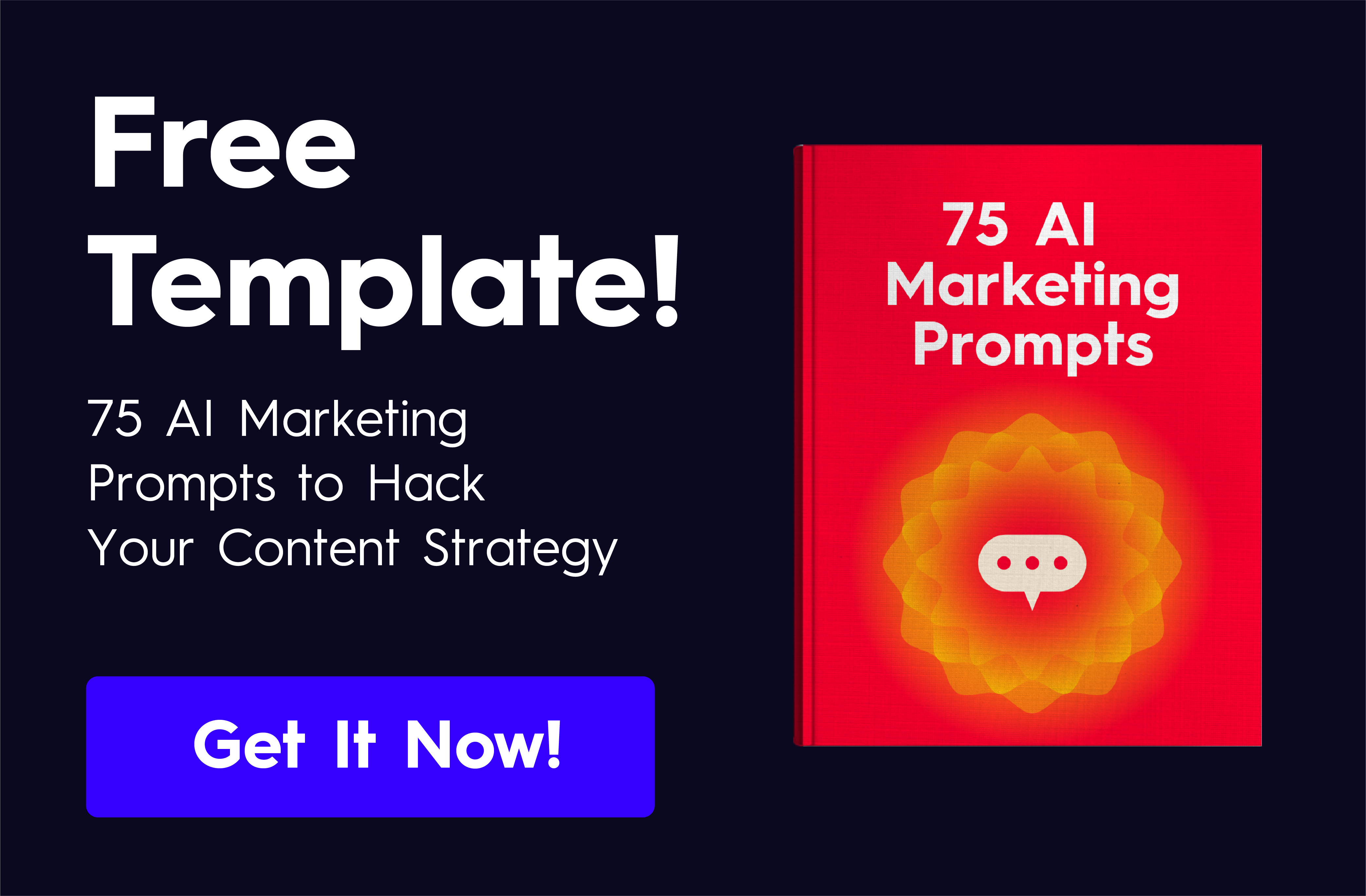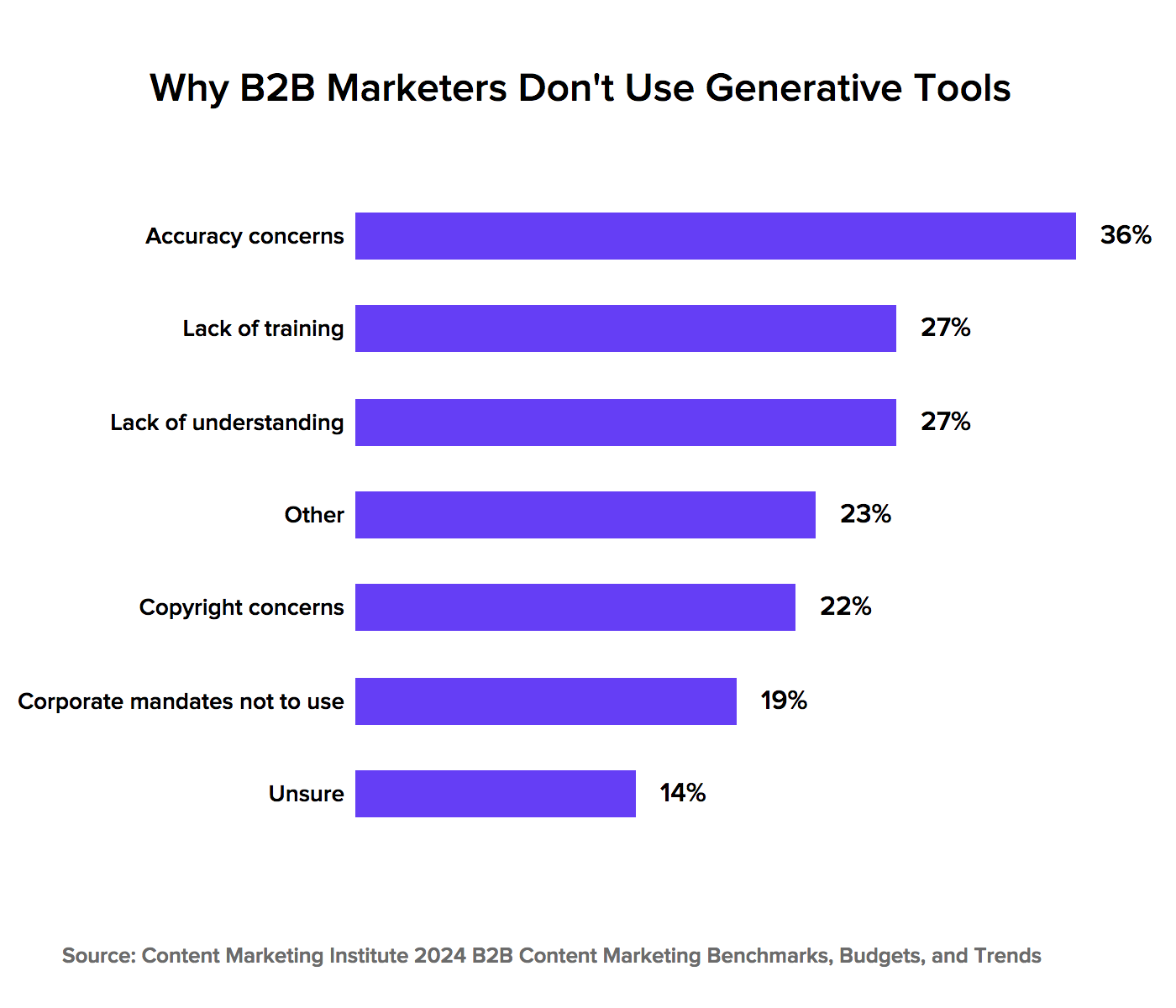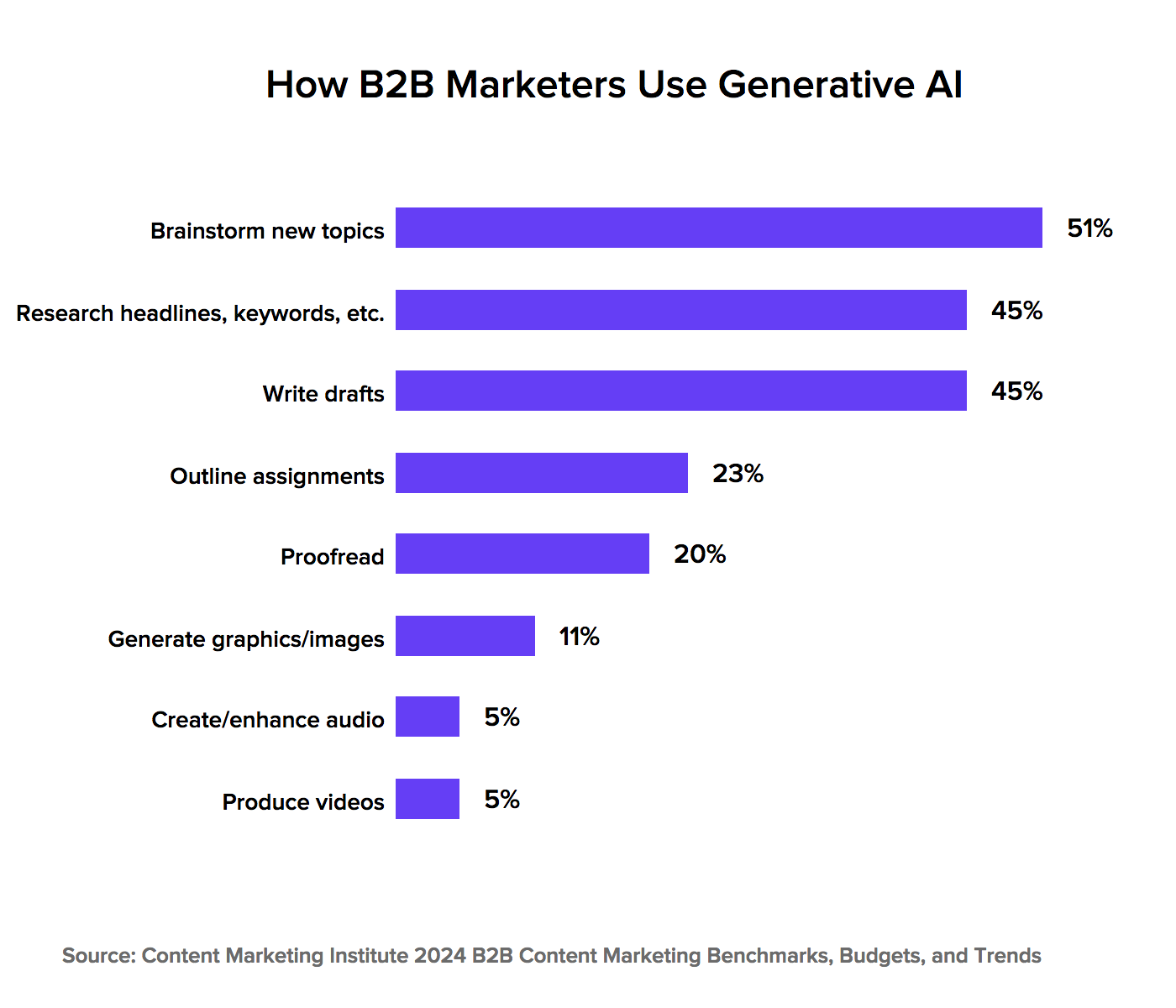There’s no denying that AI marketing is the next frontier. AI is one of the most transformative technologies that’s arrived on the scene in decades, but it’s a mystery to many marketers. It’s new. It’s intimidating. It’s overwhelming.
We understand, but we also know how important it is to your organization’s future success. Whether or not you embrace AI, your competition probably already has.
According to Gartner research, 63% of marketing leaders plan to invest in generative AI in the next 24 months.
Luckily, if you’re wondering what AI means for your job or how you can apply it effectively, you’ve come to the right place. Today, we’re breaking down everything you need to know about AI marketing, along with our best tips and a roundup of free AI prompts to help you put it to work for you.
TOC
- What Is AI Marketing?
- How Marketers Use AI
- The Benefits of AI Marketing
- The Challenges of AI Marketing
- Examples of AI Marketing
- AI Marketing Tools
- How to Create an AI Marketing Strategy
- How to Strengthen Your AI Marketing Strategy
Before we dive in, however, let’s start with the basics.

What Is AI Marketing?
AI marketing refers to the use of artificial intelligence technologies to streamline, optimize, and enhance various aspects of your marketing strategy. It leverages machine learning algorithms and data analytics to analyze consumer behavior, predict trends, and automate repetitive tasks, allowing you to make data-driven decisions, reduce manual labor, and create better brand experiences that increase conversions.
How Marketers Use AI
There are many ways marketers can and do use AI across their departments. From data analysis and predictive modeling to customer segmentation and content optimization, AI can support practically every task. However, it is especially helpful for interpreting complex data sets and providing valuable insights to guide decision-making and strategy.
This list is by no means exhaustive, and as the tech continues to grow, we will see even more applications. But these are some of the most common ways marketers can put AI to work.
- Customer Segmentation and Targeting: AI algorithms analyze vast datasets to identify patterns and segments within a target audience. This allows you to tailor campaigns to specific demographics, behaviors, and preferences.
- Personalization: AI enables personalized content and content recommendations based on user behavior and preferences. From website content to email campaigns, personalization enhances user experience and engagement. (Find out more about how to create personalized experiences with AI.)
- Chatbots and Virtual Assistants: AI-powered chatbots provide instant, round-the-clock customer support. They can answer queries, assist in purchases, and guide users through the sales funnel, improving customer satisfaction and efficiency.
- Predictive Analytics: By analyzing historical data, AI predicts future trends, customer behaviors, and market shifts. This helps you make informed decisions, optimize campaigns, and stay ahead of the competition.
- Marketing Research: AI can save you a good amount of time by helping you find information quickly—and providing information you may not have thought to search for. Whether you’re building marketing personas, searching for data points, or researching your next article, using AI as your research assistant is incredibly effective.
- Brainstorming: Whether you’re trying to come up with fresh campaign ideas, variations on a subject line, or article ideas, AI can give you great ideas to iterate. (In general, we’ve found it to be a great tool of inspiration, especially when you’ve hit a creative wall.)
- Content Creation and Optimization: AI tools can generate a variety of content, including articles, social media posts, and ad copy. Additionally, AI can optimize content by analyzing performance metrics and making data-driven recommendations for improvement.
- Design: AI tools can help you efficiently and effortlessly generate visuals for social, blog articles, white papers, and more.
- Email Marketing Automation: AI automates email campaigns by personalizing content, determining optimal send times, testing subject lines, and segmenting audiences. This ensures your emails are relevant, timely, and more likely to convert.
- Social Media Management: AI analyzes social media trends, user interactions, and sentiment to inform your social media strategy. It can also automate posts, respond to comments, and identify influencers for collaborations.
- Search Engine Optimization (SEO): AI helps marketers optimize content for search engines by analyzing keywords, user intent, and website performance. This ensures your website ranks higher in search results and reaches a broader audience.
- Ad Targeting and Optimization: AI-powered advertising platforms use machine learning to analyze user behavior and preferences. You can use this information to target audiences more effectively, optimize ad spend, and increase conversion rates.
- Customer Relationship Management (CRM): AI enhances CRM systems by providing insights into customer interactions, predicting customer needs, and automating follow-up processes. This strengthens your customer relationships and improves retention rates.
- Voice Search Optimization: With the rise of voice-activated devices, AI can help you optimize content for voice search by understanding natural language queries and providing relevant results.
- A/B Testing and Optimization: AI automates the A/B testing process by rapidly analyzing variations in campaigns and identifying the most effective elements.
- Fraud Detection and Security: AI algorithms can detect fraudulent activities, such as click fraud in online advertising. This ensures your marketing budget is spent on genuine interactions and clicks.
- Competitor Analysis: AI tools can analyze competitor strategies, pricing, and market positioning. This information helps you adjust your strategy to stay competitive.
- Augmented Reality (AR) and Virtual Reality (VR): AI enhances AR and VR experiences by personalizing content based on user interactions. This can be used to create immersive and engaging brand experiences.
Although most marketers are beginning to use AI for content creation purposes, there are so many more opportunities to put it to work.
The Benefits of AI Marketing
Considering the sheer breadth of applications, it’s clear that AI has incredible power to transform the way marketers work, eliminating a variety of time-sucking tasks, optimizing performance, and providing more valuable insights across the board. This can affect everything from employee retention to a company’s bottom line. If you’re on the fence about adopting these technologies, these are some of the biggest benefits you can expect.
- Increased productivity: As budgets tighten, marketers are asked to do more with less. (According to the Content Marketing Institute, 58% of B2B marketers cite a lack of resources as their biggest challenge.) AI-driven automation reduces manual workload for many tasks that feel like pure drudgery. This frees you and your team up to focus on the more important, satisfying work. (This can greatly influence employee satisfaction and retention.)
- Better decision-making: With access to so much data—and AI’s ability to effectively synthesize that data—you can get far more valuable insights that drive decision-making. No more guessing or losing days to data spreadsheets. The ability to automate, track, and measure with AI tools means you can drastically improve your results with less effort.
- Increased marketing ROI: Through improved targeting, personalization, and efficiency, AI tools give you a higher return on investment for marketing campaigns. (The same goes for their ability to assist with content creation.) This means you can more effectively allocate resources to channels and strategies that yield the best results.
- Innovation and creativity: AI tools can help you brainstorm a wide range of ideas for everything from your content campaigns to entertaining subject lines. This helps you explore innovative approaches to your work and can reinvigorate your team.
That said, AI is not the single technology that is going to save (or replace) us. It is still a new technology, and there are many things to consider as you incorporate it into your marketing operation.
The Challenges of AI Marketing
As the tools continue to evolve and see widespread adoption, AI marketing will face its own set of challenges. It’s important to be aware of these issues and limitations—and address them with your company and your consumers.
1) The Knowledge Gap
One of the biggest barriers to widespread adoption in marketing is the basic marketer knowledge gap. The only way to address this is through education, application, and experimentation. Many marketers are intimidated by AI, but they need to overcome the challenge to stay ahead in this dynamic field.

2) Technical Limitations
Because AI is a new technology, it is still evolving. It has built-in limitations, as machine learning is limited to what it is exposed to. It is not uncommon for AI tools to misinterpret prompts and provide limited or wrong responses. Marketers still need to use critical thinking when interacting with these tools and relying on their results.
3) Legal Issues
Ensuring the legality of data sourcing, maintaining security and proper storage practices, and complying with regulations are crucial. Marketers need to navigate the complex landscape of data protection laws to safeguard consumer privacy.
4) Social Challenges
AI algorithms are only as unbiased as the data they are trained on. Marketers need to be vigilant to prevent biases, ensure fair participation, and avoid discrimination or misidentification, which can damage brand reputation.
5) Economic Impacts
The economic impacts of AI in marketing raise questions about job delegation, potential replacements, and the need for governance to ensure responsible use. Marketers need to strike a balance between human creativity and AI capabilities.
6) Ethical Considerations
Transparency, accountability, and responsibility are ethical cornerstones in AI marketing. Marketers must be transparent about their use of AI, take responsibility for algorithmic decisions, and ensure that ethical considerations guide their actions.
Remember: This technology is new to the public as well. Your consumers may have their own concerns, so it’s important to address those proactively.
The Need for Brand Guidelines
Considering the many issues that can arise from AI use, it’s imperative to safeguard your brand. Unfortunately, according to the Content Marketing Institute, only 31% of B2B marketers say their organization has guidelines for AI use.
Before you implement these tools, make sure you understand the potential effects AI can have on your marketing, clarify your use cases, and create clear guidelines for how your organization implements it.
- Identify the best areas of application. Educate your marketing team about the capabilities and limitations of AI technologies. Ensure they have a clear understanding of how AI tools will be utilized in marketing campaigns.
- Identify risks. For example, are there security risks? Technical risks? Reputational risks? How will you identify and mitigate bias in AI algorithms?
- Craft your organizational perspective/guidelines. Clearly articulate ethical principles that guide the use of AI in marketing. Consider aspects such as privacy, transparency, fairness, and accountability. Establish a commitment to compliance with relevant regulations and industry standards.
- Be transparent with your audience. Clearly communicate to customers when AI is being used, especially in personalized recommendations and automated interactions. Define guidelines for obtaining and managing customer consent for data collection and AI usage. Ensure compliance with data protection regulations, and establish protocols for handling and securing customer data.
For more details, see our guide to write brand guidelines in 5 steps.
Tip: It helps to establish an AI team in-house that can ensure team members understand how to use tools and interpret AI-driven insights and decisions.
Examples of AI Marketing
That said, AI marketing has and will continue to be transformative for many brands. We’ve seen more and more companies see massively impressive results, often by implementing simple AI tools and experiments that deliver strong results. For example:
- Vanguard is one of the world’s largest investment companies, and they work in a highly regulated space—especially when it comes to advertising claims. To reach their B2B audience on LinkedIn, they used Persado, an AI content generation tool, to draft and test 64 variations of messaging. They ultimately honed in on the strongest messaging, which helped increase their CTR by 15.76%.
- OkCupid is known for the detailed questions it uses to match users and help them get to know each other. To get more inspiration for these questions, they asked Chat GPT what questions it would ask on a date. After turning the best answers into a multiple-choice quiz, the team saw OkCupid users answer the questions over 600,000 times.
- Gumtree was the first free classified ads site in the UK, but over time they’d seen their email open and CTR rates drastically decline. Eager to connect with their audience, they used Phrasee, a generative AI tool, to revamp their email messaging. After using the tool, they increased their open rates by 35% and their CTR by 44%.
- Wowcher is a daily deals brand that also used Phrasee to improve Facebook and Instagram ad copy, achieving a 31% reduction in Cost Per Lead.
- Hospitable is a platform that automates short-term rental management. By implementing Intercom’s AI chatbots to assist with customer support, they saw a 95% reduction in response times, cleared a queue of 500 backlogged inquiries, and were able to automatically resolve 30% of all inbound support questions.
- Arduino, a platform that enables users to create interactive electronic objects, wanted to interact with site visitors more effectively. By Using Twilio Segment and CustomerAI, they were able to synthesize hundreds of data points across 12 websites and various APIs to compliantly predict customers’ shopping intentions. This increased the accuracy of their audience segments by 70% and allowed them to focus their ad spend on ready-to-buy consumers while providing personalized assistance to more casual browsers.
Of course, no matter what your goal or use case is, you need the right tools to win with AI.
AI Marketing Tools
There are plenty of tools that can help you with all sorts of tasks, from chatbots and predictive analytics software to content creation and customer segmentation. Before you adopt any tool, however, there are a few questions to ask.
- What specific problem or opportunity are you trying to address with AI?
- How will the AI tool help you achieve your strategic objectives?
- Do you have the necessary data to train and use the AI tool effectively?
- How will you ensure fairness, transparency, and accountability in the AI’s decisions?
- What resources (e.g., budget, expertise) are required to implement and maintain the AI tool?
- How will the AI tool integrate with your existing systems and workflows?
- What key performance indicators (KPIs) will you use to evaluate its impact?
- What training and support will be provided to users?
- How will you ensure that the AI tool remains effective as technologies and requirements evolve?
These questions are crucial to ask, but they should not dissuade you from experimenting with tools. They should simply provide guard rails as you experiment.
Tip: See our roundup of the 50 best AI marketing tools to see which tools might be right for you.
How to Create an AI Marketing Strategy
Now that we’ve covered the capabilities and considerations of AI, let’s talk about how you can build an AI marketing strategy that will help maximize your output and achieve better results and ROI.
But before we proceed, make sure to download our free template of 75 AI Marketing Prompts to use as you build your strategy.
1) Define your goals.
Whether it’s increasing brand awareness, improving lead generation, enhancing customer engagement, or optimizing conversion rates, having clear goals will guide your strategy—and make it easier to measure success.
Tip: See our free guide to set realistic marketing goals, and use AI-powered analytics tools to analyze historical data related to your goals. This will help you set benchmarks and build a strategy that sets you up for success.
Note: Although you may base your marketing goals on the insights gained from predictive models, do a sanity check to ensure they’re aligned with realistic outcomes, market conditions, etc.
2) Identify Your Audience.
The more you understand your audience, the easier it is to create a marketing strategy that will resonate with them. Fortunately, AI tools can easily help you get an accurate picture of your audience and help you set specific marketing goals for each segment.
Tip: Utilize AI to analyze customer data and behavior, including things like demographic information, purchase history, online activities, and preferences. This can help identify patterns and insights you might otherwise miss. Predictive analytics can also forecast trends and customer behavior, helping you anticipate your audience’s needs (and tailor content accordingly).
With this info, you can use our guide to build clear marketing personas, which are a particularly helpful tool to brainstorm and vet campaign ideas.
3) Map your buyer journey.
If you want to be successful, you need to optimize every stage of your buyer journey to help your audience take the next step. Luckily, AI can help you both reduce strain on your team and improve your audience’s brand experience.
Think about how you can implement AI at various stages to improve your results.
- What are the most critical touchpoints for engagement?
- How and where can you add personalization to tailor your marketing messages to individual preferences?
- Where can you integrate AI-powered chatbots and virtual assistants to improve customer support and engagement?
Note: You’ll want to establish goals for improving personalization over time, as AI continuously learns from customer interactions.
Tip: Use our free template to map your buyer journey. This can help you better visualize the journey and define marketing goals for each stage of the customer lifecycle (e.g., acquisition, retention, and advocacy).
4) Determine your measurement approach.
No strategy is worthwhile if you can’t measure its success. Whether you use the OKR method (objectives and key results) or an alternative measurement system, it’s important to understand what you will measure and why.
- Implement robust analytics to measure the performance of your AI-driven marketing initiatives.
- Regularly analyze the data, gather insights, and use these findings to refine and optimize your strategy over time.
Tip: See our guide to choose the right metrics for your content marketing strategy.
5) Identify your channels.
Choosing the right channels is the key to meeting your customers where they are. AI insights can help you identify the best channels for your brand—and optimize content to perform even better.
- Implement AI tools for attribution modeling to understand the impact of different marketing channels on conversions.
- Maximize your budget by optimizing your marketing mix based on attribution insights.
- Use sentiment analysis tools to monitor social media and online conversations. This can help you gauge public opinion about your brand and products, allowing you to respond effectively to both positive and negative sentiments.
Tip: You don’t have to target every channel simultaneously. (In fact, overextending yourself will reduce your success across all channels.) Instead, find out how to choose the best channels for your goals.
6) Review your tech stack.
It’s always smart to review your tech stack to see what’s working and what you can improve on. You may already use some AI tools, but there are plenty more (as well as AI additions to your existing tools) you may want to explore to increase productivity, eliminate unnecessary tasks, or optimize your work.
Most importantly, ensure that anything you adopt supports your goals and integrates seamlessly into your existing marketing stack.
Tip: As AI tools require their own learning curve, it can be helpful to assign certain team members to explore different tools and teach the rest of the team. (Again, you can explore our roundup of 50 AI marketing tools to see what tech you might want to experiment with.)
7) Create campaigns.
Once you have your foundation laid and your tools implemented, you can bring your strategy to life one campaign at a time.
Use AI to ideate campaign ideas based on your goals, channels, and audience. AI can also identify the most effective keywords, audience segments, and ad creative to improve ROI. (AI-driven ad platforms can automatically adjust bidding strategies and target the most relevant audience segments.)
Tip: Ensure your AI marketing campaigns comply with relevant regulations and ethical standards. Respect user privacy, be transparent about data usage, and implement measures to mitigate biases in AI algorithms. For more tips, see our guide to create successful marketing campaigns.
8) Measure and iterate.
The biggest benefit of AI is its power to extract insights from data. This is why it’s so important to document your goals and implement the right infrastructure to measure them.
As you launch campaigns, create AI-driven dashboards to track performance, and set goals to make adjustments based on current performance metrics.
Tip: Make sure to test your tools to ensure you have the correct infrastructure set up.
How to Strengthen Your AI Marketing Strategy
Creating a strong AI marketing strategy is an ever-evolving process. The more you incorporate different tools, the more you’ll grow, tweak, and improve. But there are a few things you can do to ensure you’re always growing in the right direction.
- Regularly review your strategy. Marketing is never a set-it-and-forget-it thing. Review your strategy quarterly to make sure it still aligns to your goals. Depending on the market, your audience, or business goals, you may need to make significant changes—and that’s OK.
- Establish benchmarks for the adoption of emerging AI tech in your marketing strategy. Again, we realize that AI is a whole new world, and it can be especially intimidating to tackle all at once. If you want to see your marketing operation improve over time, set goals for adopting new practices and testing new tools.
- Foster a culture of experimentation. You can only evolve if you give yourself room to grow, experiment, or make mistakes. AI tools can help you increase your innovation and creativity, but only if you give your team the chance to properly experiment with them. As previously mentioned, you may encourage some people or teams to experiment with a new technology and report back what they’ve learned. That doesn’t mean you have to adopt every single tool, but it will help you expand your knowledge and better understand what’s possible.
Most importantly, keep an open and enthusiastic mindset when it comes to AI tools. We consider AI to be a great servant, not a great master. With critical thinking and smart implementation, it can transform the way you do your job—and the results you get accordingly.
That said, if you’re curious to know more about how AI can help your team, consider bringing in a partner with the right AI knowledge. We’d be happy to talk about how AI can improve your marketing, or help you get a sense of what you may or may not need. (If you’re curious, find out more about what it’s like to work with us on your AI strategy.)
Otherwise, remember the best way to stay ahead of the competition is to stay up-to-date on the latest best practices in marketing. If you need a fresh source of inspiration, subscribe to our Best Story Wins podcast, where we’ll continue conversations about how AI is helping industry experts win hearts, minds, and market share.






